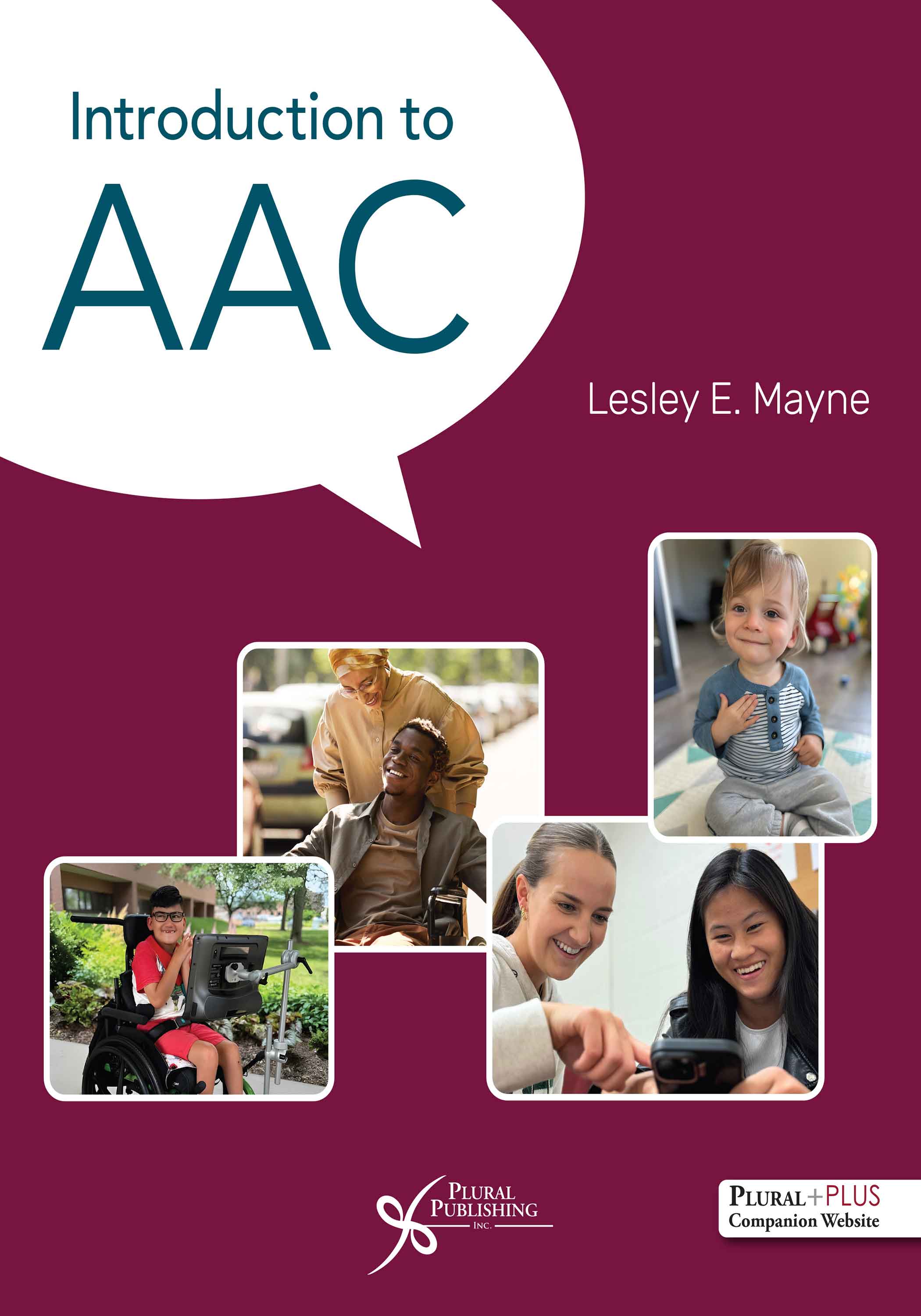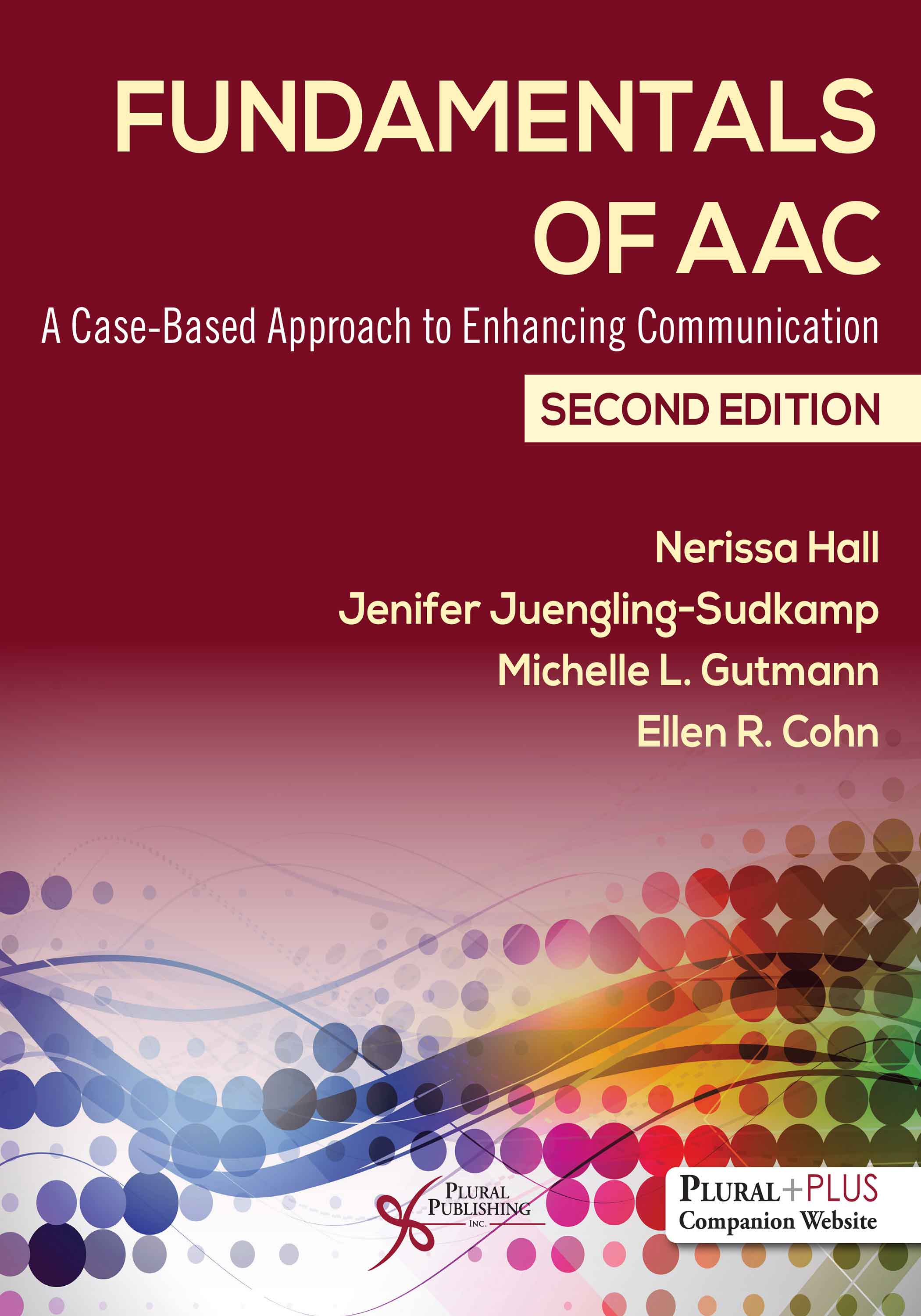
Introduction to AAC
First Edition
Lesley E. Mayne
Details: 458 pages, B&W, Softcover, 7" x 10"
ISBN13: 978-1-63550-779-9
© 2027 | Available
For Instructors
Purchase
Written specifically for undergraduate-level and speech-language pathology assistant students, Introduction to AAC presents an introduction to the knowledge and skills in augmentative and alternative communication (AAC) that support people across the lifespan in the cultures in which they live and people with whom they interact. It presents the foundational knowledge of AAC in a way that is engaging for students, incorporating pedagogical elements designed to encourage active learning such as quick application tasks in a Mindful Minute, time for Reflection, and Integration Tasks that promote critical thinking that are embedded in each chapter. The text invites the reader to build AAC skills and knowledge including assessment and intervention, AAC technology, literacy, and communication partner support that culminates in a final chapter on AAC intervention session design.
Key Features
- Bolded terms: Allows students to visually landmark on important concepts, create associations with the surrounding text, and identify them again more easily when preparing for assignments, projects, exams, and application in real life.
- Case studies: Numerous cases and vignettes create an opportunity to blend conceptual knowledge with a real-world person. They play a vital role in creativity, allowing students to consider application of concepts to someone that they may work with or support in their future.
- Mindful Minutes: Engagement tasks ask the learner to act upon the concepts by practicing or thinking about what was read. These opportunities generate action and provide a different way for learners to cognitively engage with the concepts in addition to reading.
- Reflections: Encourage students to think about their experiences, activate background knowledge, or consider concepts as they may be new or offer a different perspective.
- Integration Tasks: Chapter questions are posed before the Conclusion so students engage with learning outcomes. Each chapter offers concept check questions, application opportunities, and For Thought… statements. Therefore, students are invited to become active participants with the text and bring their own experiences to each chapter.
PluralPlus Online Ancillaries
For instructors: PowerPoint Slides, Test Bank, Class Activities, Syllabus, Case Studies, Videos
For students: Quizzes, eFlashcards, Activities/Exercises, Links to Related Resources
Reviews
“This textbook offers a comprehensive and engaging exploration of AAC, seamlessly blending clear explanations with practical examples. It provides an in-depth understanding that is both accessible and insightful, making it an invaluable resource for undergraduate students/learners and professionals alike. With its thorough coverage and well-organized structure, this book is an essential addition to any CSD library.”— Diana Blakeney-Billings, PhD, AuD, CCC-A, Alabama A&M University
“It provides valuable insights that are highly relevant across multiple levels of expertise, including undergraduate and graduate students, as well as individuals pursuing careers as speech-language pathology assistants. By addressing foundational concepts and practical applications, the content serves as a versatile resource, bridging theoretical knowledge with real-world practice. This ensures that learners at different stages of their academic and professional journeys can benefit from the material, enhancing their understanding and ability to implement effective strategies in speech-language pathology.”— Amanda Buchheit, Brothers Educational Consulting/Cal Baptist University
“The authors have covered the material in a friendly and approachable manner. The mindful minute, reflections, case studies, and integration tasks support cognitive mediation for the students. I also like the application tasks and concept checks. This text is clearly connected to clinical work and provides a strong foundation for future practitioners.”
—Margaret Vento-Wilson, PhD, CCC-SLP, Assistant Professor, California State University Long Beach, College of Health and Human Services, Department of Speech-Language Pathology
“Concept check questions at the end of each chapter actively engage the students in summarizing the key ideas that were presented. The inclusion of many graphics and visuals along with links to tools and resources available on the internet helps to ensure understanding and allows students to implement knowledge as they learn the concepts. By providing multiple application activities for each chapter, the author provides options for instructors to assign activities most appropriate for their method of course delivery or to allow students to choose activities that they are most interested in.”—Jennifer Schultz, Mitchell Technical College
Table of Contents
Foreword
Preface
About the Author
Acknowledgments
Reviewers
Dedication
Chapter 1. Multimodal Communication: The Nuts and Bolts of AAC
Perspective
Learning Objectives
Hold On…What Is AAC?
AAC Key Concepts
Language and Literacy
Communication
AAC Purposes of Communication
The Four Purposes of Communication
Communication Contexts
Technology
AAC: Under the AT Umbrella
Mindful Minute Overview
The Art of Observation
AAC and AT Connections
AT and AAC Technology
AAC Technology Terms
AAC Assessment and Intervention
AAC Assessment
AAC Intervention
World Health Organization International Classification of Functioning, Disability, and Health (WHO-ICF)
AAC 10 Rules of Commitment
An Overview of Integration Tasks
Chapter 1 Integration Tasks
Concept Check
Application Activities
For Thought…
Conclusion: What You Learned. Why It Matters. What’s Next?
What Did I Learn?
Why Does It Matter?
What’s Next?
References
Chapter 2. An AAC Architectural Plan and Ethics
Perspective
Learning Objectives
Purpose, Rationale, and Benefit of an AAC Architectural Plan
Who Is Your AAC Communicator?
What Is MY Plan for Selecting Vocabulary?
Applying the AAC Four Purposes and Competencies to Vocabulary Planning and Selection
Four AAC Purposes of Communication
Four AAC Competencies
Ethics
Examples of Ethical Considerations
Awareness of Ethical Decision Making in AAC
Chapter 2 Integration Tasks
Concept Check
Application Activities
For Thought…
Conclusion: What You Learned. Why It Matters. What’s Next?
What Did I Learn?
Why Does It Matter?
What’s Next?
References
Chapter 3. AAC Technology
Perspective
Learning Objectives
AAC Technology
Nonelectronic Low-Tech AAC
Access
Communication Devices for Visual Impairments
Static Low- and Mid-Tech Speech-Generating Devices
High-Tech or Dynamic Display Speech-Generating Device Features
AAC Applications
Chapter 3 Integration Tasks
Concept Check
Application Activities
For Thought…
Conclusion: What You Learned. Why It Matters. What’s Next?
What Did I Learn?
Why Does It Matter?
What’s Next?
References
Chapter 4. AAC Assessment Findings
Perspective
Learning Objectives
AAC Assessment Overview
AAC Assessment Report
Background Information: Referral, Case History, and Diagnostic Questions
Types of AAC Assessment Measures Found in AAC Reports
AAC Assessment Tools
AAC Assessment Report Areas
Multimodal AAC: Technology, Access Methods, and Nonverbal Communication
Discussion With Recommendations
Funding Process Overview
Reassessment
Chapter 4 Integration Tasks
Concept Check
Application Activities
For Thought…
Conclusion: What You Learned. Why It Matters. What’s Next?
What Did I Learn?
Why Does It Matter?
What’s Next?
References
Chapter 5. Common Questions, Myths, and AAC Feature Matching
Perspective
Learning Objectives
Common Questions About AAC
What Are the Prerequisites for a Child or Adult to Use AAC?
Will Implementing AAC Interfere With a Person’s “Natural Voice”?
Which is Better? Low-Tech, Mid-Tech, or High-Tech?
What if the Person Is Not Using the AAC Device How We Thought They Would?
Do Symbols Matter?
AAC Myths, Misconceptions, and Practice Issues
AAC Feature Matching
AAC Device Feature Matching
Feature Matching: Feasibility
Technology Considerations and Personal Feature Matching Questions
Chapter 5 Integration Tasks
Concept Check
Application Activities
For Thought…
Conclusion: What You Learned. Why It Matters. What’s Next?
What Did I Learn?
Why Does It Matter?
What’s Next?
References
Chapter 6. AAC Vocabulary Planning and Selection
Perspective
Learning Objectives
Considerations in Planning and Selecting Vocabulary
Options for Vocabulary Planning and Selection
Interest-Based Surveys and Questionnaires
Core and Fringe Vocabulary
High-Frequency Words
Unstructured and Structured Observations
Just-in-Time (JIT) Supports: Implications for Vocabulary Selection
Literacy
Domains of Language
Purposes of Communication (Light, 1989)
Chapter 6 Integration Tasks
Concept Check
Application Activities
For Thought…
Conclusion: What You Learned. Why It Matters. What’s Next?
What Did I Learn?
Why Does It Matter?
What’s Next?
References
Chapter 7. An AAC Action Plan for Implementing Vocabulary
Perspective
Learning Objectives
My Action Plans for Implementing Vocabulary
Approaches for AAC Vocabulary Implementation
Activity-Based Approach
Routine-Based Approach
Topic Setting + Script Approach
Just-in-Time (JIT) Approach
Vocabulary by Month Approach
Chapter 7 Integration Tasks
Concept Check
Application Activities
For Thought…
Conclusion: What You Learned. Why It Matters. What’s Next?
What Did I Learn?
Why Does It Matter?
What’s Next?
References
Chapter 8. Key AAC Interventions
Perspective
Learning Objectives
Fundamental Preparation: Know Before You Go Into AAC intervention
Attention
Responsivity: Determining and Establishing Intent
Natural Consequences
Symbolic Understanding
Yes or No?
Key AAC Interventions in Action: Thinking and Doing
Communication Temptations
Aided Language Stimulation
Making Choices
Causing Action
Visual Supports
Therapeutic Goal or Communicative Intent?
Just-in-Time Therapy
AAC Intervention Method Programs
Pivoting During AAC Intervention
Chapter 8 Integration Tasks
Concept Check
Application Activities
For Thought…
Conclusion: What You Learned. Why It Matters. What’s Next?
What Did I Learn?
Why Does It Matter?
What’s Next?
References
Chapter 9. Integrating Language and AAC Strategies in Intervention
Perspective
Learning Objectives
Analytic Language
Domains of Language
Examples of Domains of Language Through AAC Icons
Echolalia and Gestalt Language Processing
Communication Disorders Secondary to Acquired Brain Injury
Language Intervention Strategies
Explicit Language Strategies With AAC Application
Implicit Language Strategies
Sensory Information and Assistive Technology
Chapter 9 Integration Tasks
Concept Check
Application Activities
For Thought…
Conclusion: What You Learned. Why It Matters. What’s Next?
What Did I Learn?
Why Does It Matter?
What’s Next?
References
Chapter 10. Literacy and AAC
Perspective
Learning Objectives
The Literacy Charge
Literacy Opportunities With AAC
A Note on Literacy and Images on Icons
You Have to Invest! (Rendall, 2017)
Literacy and AAC Across the Lifespan
The Common Core State Standards: Literacy Opportunities Abound
Technical Reading Skills to Support People Using AAC
Literacy Instruction for Individuals With Autism, Cerebral Palsy, Down Syndrome, and Other Disabilities (Light & McNaughton, 2019)
Accessible Literacy Learning Application
Transition to Literacy (T2L)
Nonverbal Reading Approach
Emergent Literacy
Conventional Literacy
Conceptual Literacy
Comprehension + 1
Conceptual Literacy Development for People Using AAC
Create Memories With Literacy
Ebooks
AAC Literacy Materials
Chapter 10 Integration Tasks
Concept Check
Application Activities
For Thought…
Conclusion: What You Learned. Why It Matters. What’s Next?
What Did I Learn?
Why Does It Matter?
What’s Next?
References
Chapter 11. Culturally Responsive AAC Engagement
Perspective
Learning Objectives
Terminology in the Conversation of Culturally Responsive Practice
Understanding Your Culture
Professional Training in Culturally Responsive Practice and AAC
Common AAC Training Approach
AAC Cultural Disparity
Phonemic Inventories and Cultural and Linguistic Information Across Languages
Culturally Responsive Practices
Application to the AAC Competencies
Application to the AAC Purposes of Communication
Working With Interpreters
Culturally Responsive Session Design
Chapter 11 Integration Tasks
Concept Check
Application Activities
For Thought…
Conclusion: What You Learned. Why It Matters. What’s Next?
What Did I Learn?
Why Does It Matter?
What’s Next?
References
Chapter 12. Coaching AAC Communication Partners
Perspective
Learning Objectives
Build Capacity (McNaughton et al., 2018)
AAC Key Stakeholders’ Knowledge and Skills
Parents as Experts and Learners in the AAC Process
Communication Partners for Adults Using AAC
Teachers
Paraprofessionals
Peers
Chapter 12 Integration Tasks
Concept Check
Application Activities
For Thought…
Conclusion: What You Learned. Why It Matters. What’s Next?
What Did I Learn?
Why Does It Matter?
What’s Next?
References
Chapter 13. AAC Goals and Progress Monitoring
Perspective
Learning Objectives
AAC Goal Documentation
Internal and External Goal Factors
Goals Drive Intervention
The Thinking Behind Goal Writing: SMART Goals
The Doing Behind Goal Writing
Planning Goal Writing
Step 1: Date
Step 2: Do
Step 3: Stimulus
Step 4: Cueing
Step 5: Criterion
Step 6: Mastery
Step 7: Measurement Tool
Cueing and Prompting Versus Facilitated Communication
Cueing Hierarchy
Progress Monitoring
Practice With Progress Monitoring and SOAP Notes
Chapter 13 Integration Tasks
Concept Check
Application Activities
For Thought…
Conclusion: What You Learned. Why It Matters. What’s Next?
What Did I Learn?
Why Does It Matter?
What’s Next?
References
Chapter 14. Designing an AAC Intervention Session
Perspective
Learning Objectives
Building Blocks of Therapy
AAC Intervention Session Structure
AAC Intervention: A Framework
AAC Intervention Session Design Elements
Chapter 14 Integration Tasks
Concept Check
Application Activities
For Thought…
Conclusion: What You Learned. Why It Matters. What’s Next?
What Did I Learn?
Why Does It Matter?
What’s Next?
References
Glossary
Index
Introduction to AAC comes with access to supplementary student and instructor resources on a PluralPlus companion website.
The companion website is located at: https://www.pluralpublishing.com/publication/iaac
STUDENTS:
The student resources include Quizzes, eFlashcards, Activities/Exercises, and Links to Related Sources.
To access the student resources, you must register on the companion website and log in using the access code located in the front of your textbook.
INSTRUCTORS:
The instructor resources include PowerPoint Slides, Test Bank, Class Activities, Syllabus, Case Studies, and Videos. You will also have access to all of the student resources listed above.
To access the instructor resources, you must contact Plural Publishing, Inc. to be verified as an instructor and receive your access code.
Email: instructormaterials@pluralpublishing.com
Tel: 866-758-7251 (toll free) or 858-492-1555
*Note for students: If you have purchased this textbook used or have rented it, your access code will not work if it was already redeemed by the original buyer of the book. Plural Publishing does not offer replacement access codes for used or rented textbooks.

Fundamentals of AAC: A Case-Based Approach to Enhancing Communication
Second Edition
Nerissa Hall, Jenifer Juengling-Sudkamp, Michelle L. Gutmann, Ellen R. Cohn
Details: 574 pages, B&W, Softcover, 8.5" x 11"
ISBN13: 978-1-63550-773-7
© 2027 | Available

